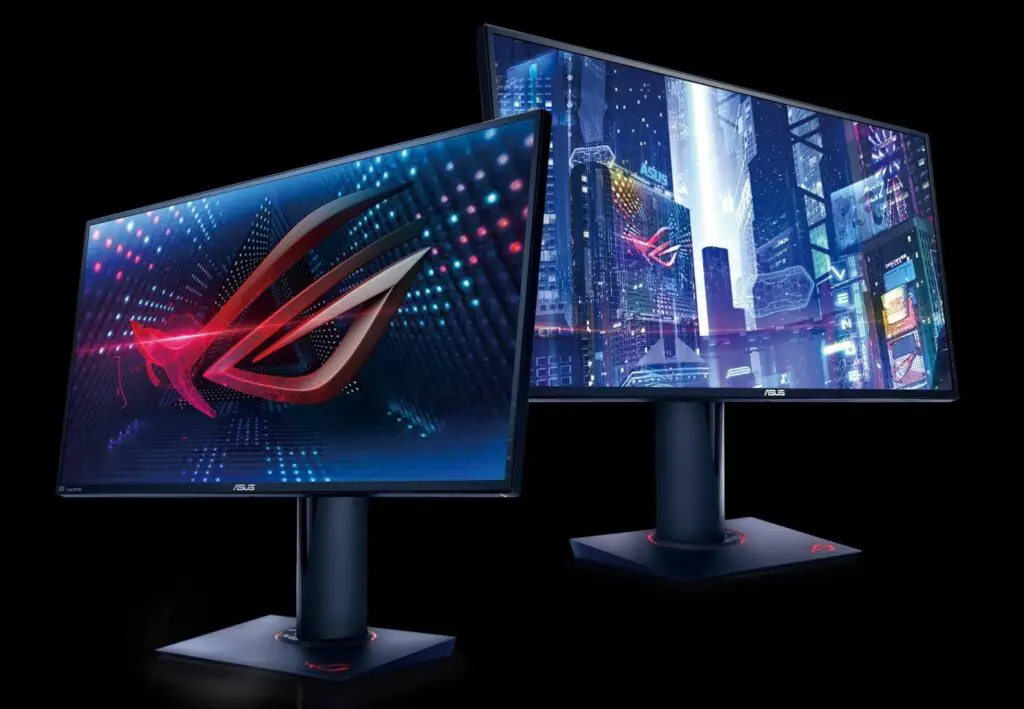Looking for the best monitor size for gaming? You have come to the right place!
The best monitor size for gaming is 24 inches, as it is still the most common size for 1080p screens. If you are going to play games at 1080p, then you should avoid having a monitor that is larger than 24 inches, otherwise, you will see the individual pixels and that will break the dive.
Apart from that, you can opt for a larger screen if you want to play 1440p or 4K. Larger screens work well if they offer higher resolutions, but if you like to sit near the screen, then you should avoid getting a screen that is larger than 27 inches, as it will not be comfortable.
When choosing the best monitor size for gaming, there are different factors to consider, including screen resolution and the type of games you usually play.
Although some might say otherwise, bigger is not always better with respect to the size of the monitors. With this guide, we will help you choose which monitor size is best for your gaming preferences.
As players, we know that the size of the monitor can make or break the game. Yes, computer clock speed, refresh rate and response time are also important.
But the right monitor can be the difference between detecting your opponent or not.
So what is the best monitor size for gaming?
If all those questions confused or alarmed you, don’t worry. We are here to help you with everything, and today we will help you choose the right monitor by explaining the best monitor size for gaming.
There are many factors to consider when making a decision. Read on to understand how to choose the monitor size for your gaming needs.
What is Monitor Size, and Why is it Important?
The display size of a monitor is the display area, also known as the screen, measured diagonally from one corner to another. Simple truth?
That said, there is no better monitor size, as it depends on your personal preferences and how much space you have available. In general terms, larger monitors cost more than small ones and present sharper screen images. But this is not always the case since it really depends on the resolution of the monitor.
Resolution is measured in pixel density or PPI. The more pixels per inch, the higher the resolution.
If a 24 “screen has a resolution of 1080p (1920 x 1080 pixels on the horizontal and vertical axes), the pixels per inch are 91 PPI. However, if you have a 30” screen with 1080p resolution, the pixels will be They extend even more. This leaves you with only 75 PPI. Too granulated for modern games, if you ask us.
What are the standard monitor sizes on the market?
22-inch Monitors
[amazon box=”B00EZSUWFG” template=”vertical”]Considered on the smaller side today, 22-inch monitors often have a resolution of 1366×768 at 1920×1080 (Full HD / 1080p). These have been eliminated by the extension of the 24-inch monitors, but occasionally you will see some of them in the wild.
24-inch Monitors
[amazon box=”B074FKB5WD” template=”vertical”]If you sit within three feet of the screen, the 24-inch monitors are for you. They are not overwhelming when viewed closely and will allow you to see the full screen easily, which is great if you play mainly competitive games like Counter-Strike: Global Offensive and Overwatch.
In many games, it will also be easier to verify all the game information displayed on the edges of the screen, such as your character’s minimap and HP / MP, among others.
For 24-inch monitors, the recommended resolution is 1920 × 1080 (Full HD). That will give you a pixel density of about 92 pixels per inch (PPI). If you want a higher resolution, you can see 24-inch screens with a resolution of 2560 × 1440 (QHD), such as the Dell S2417DG and the AOC Agon AG241QX.
While there are also 24-inch monitors with a resolution of 3840 × 2160 (4K UHD), they are not the most recommended for games. That kind of resolution is best experienced on a screen of a size equal to or greater than 27 inches, especially if your diet consists mainly of action role-playing games and open-world games with beautiful images.
Screens of less than 24 inches are also good options, especially if you have a very small desk. As with 24-inch monitors, the ideal resolution for monitors less than 24 inches is 1080p.
There are 22 and 23-inch monitors that have adaptive synchronization technology and an update frequency of more than 60 Hz, but they are not as popular as 24-inch game monitors.
There are also 25-inch monitors in the market. Like 24-inch monitors, they usually come with a resolution of 1080p or 1440p and are good options if you sit near the screen.
If you believe that 25-inch monitors are more suitable for you, see the Dell U2518D, one of the best IPS monitors that exist.
27-inch Monitors
Monitors with a screen size of 27 inches are excellent if you usually sit three or four feet from the screen. If you are sitting too close to a 27-inch monitor, you will have more difficulty viewing the entire screen and processing everything that happens in the game, which could be expensive in fast-paced competitive games.
If you love admiring the landscape in games like The Witcher 3: Wild Hunt and The Elder Scrolls V: Skyrim, choose 27-inch monitors but make sure you also have the correct resolution. For 27-inch monitors, the optimum point is QHD or 1440p, which translates into a pixel density of about 109 PPI. With a resolution of 1440p, you get sharper texts and more detailed images. That is also true for 28-inch game monitors, which are less common than 27-inch monitors.
You can also consider 27-inch screens with a 4K resolution, but keep in mind that most 27-inch 4K monitors have a 60 Hz limit. On the other hand, there is a good selection of 27-inch QHD game screens with a standard refresh rate of 144 Hz, the Asus ROG Swift PG279QZ and the Dell S2716DG being some of the most notable. If you want a versatile monitor that works well for both accelerated games and story-based games, choose a 27-inch QHD monitor with a high refresh rate.
32-inch Monitors
Large monitors like the LG 32UD99-W and the BenQ EW3270U are best used for games with beautiful graphics like Final Fantasy XV and Hellblade: Senua’s Sacrifice. They are also excellent for local multiplayer mode, as their large screen allows more fun split-screen multiplayer sessions with your friends. But, on the other hand, they are not recommended for competitive games because the screen is too big for you to see the full screen without much head movement.
Monitors with a diagonal size of 32 inches are suitable if you usually sit more than five feet away from the screen, such as when playing on home consoles, where large televisions are commonly used. For a non-ultra wide monitor of more than 30 inches, the ideal resolution is 4K UHD, which translates into a high pixel density.
You can also opt for a 32-inch QHD screen, which has approximately the same pixel density as a 24-inch Full HD screen. Unless you are absolutely fine with pixelated images, the ones you want to avoid are 32-inch screens with a resolution of 1080p, especially if you also plan to use your monitor for general use and productivity.
34-inch Ultrawide Monitors
If you want a more immersive experience and a wider field of vision when you play, check out the ultra-wide gaming monitors. While they are definitely not for everyone, they are excellent for games like DOOM, Assetto Corsa, The Witcher 3: Wild Hunt and Assassin’s Creed Origins.
The most common size of ultra-wide monitors is 34 inches, and many of the products that fit that description also feature a curved screen for an even more immersive gaming experience. The Dell Alienware AW3418DW, the Acer Predator X34P, and the Asus ROG Swift PG348Q are some of the most notable examples.
For ultra-wide 34-inch monitors, curved or not, you’ll want to sit at a distance of two to four feet from the screen to get the best experience. However, everyone has different preferences, so feel free to sit within two feet of the screen while playing racing games and flight simulators.
As for the resolution, many 34-inch ultra-wide screens come with a resolution of 3440 × 1440, which translates into a good pixel density of around 109 PPI. If you are looking for a versatile monitor, 34-inch ultra-wide monitors are also good for productivity, whether curved or flat. They are excellent for multitasking with multiple windows open at the same time.
Anything larger than an ultra-wide 34-inch monitor is not recommended for games. They are simply too large and take up a lot of desk space. They are best suited for productivity since all that screen space allows for easy multitasking. If you want a screen of more than 34 inches for games, we recommend you choose a 4K TV.
Is a Bigger Monitor Better for Gaming?
The best monitor size for gaming depends on the resolution you prefer and the viewing distance. The general rule is that if you are going to be near the screen, 24 inches is enough. If you need a larger screen or a higher resolution, you can opt for a 27-inch screen, but it should not go higher than that.
What about Ultrawide Displays?
Most monitors have an aspect ratio of 16: 9. There are some that have an aspect ratio of 16:10, but they are quite rare.
Today we have ultra-wide screens that have an aspect ratio of 21: 9. These monitors can be excellent for games, especially if you have a high-resolution model. The problem appears in games that do not support these larger screens.
Modern FPS games do not support a horizontal FOV of more than 90 degrees. While this is fine for a standard monitor, it can cause stretching and image distortion on ultra-wide screens. This is something that breaks the dive and just doesn’t look good.
What about multi-display setups?
Multiple screen configurations are another can of worms. No one seems to agree on the correct screen size, how many screens you should have, in what configuration you should run them.
But playing with these can be quite good, especially if you run them in a 1×3 or 3×3 configuration. They offer a level of immersion similar to that of an ultra-widescreen, but … the same problems that apply with ultra-wide games apply here.
Generally speaking, you don’t need to worry so much about compatibility here, since you can still play a full-screen game on a monitor and use the rest of your monitors for something else.
What is the Best Monitor Size for Gaming?
There is no real answer to this question. Everyone has different preferences, so there is no perfect monitor size that suits all players. But in general, the 24 and 27-inch monitors are the most suitable for playing.
If you sit within three feet of the screen and/or love to play fast-paced first-person shooting games, the best monitor size is 24 inches, with a recommended resolution of 1080p. If you sit three or four feet from the screen and/or have a balanced game diet composed of slow-paced games with lovely images and competitive fast-paced games, the best monitor size is 27 inches, with an ideal resolution of 1440p
Conclusion
The size of the game monitor should be in accordance with the resolution and viewing distance.
The correct size also depends on whether it is an ultra-wide or standard 16: 9 format screen. If it goes with a standard flat-panel monitor, then 24 inches is ideal for a resolution of 1080p. If you plan to get a larger screen, then you should increase the resolution to 1440p or 4K.
While a curved game monitor has its advantages, they are quite expensive. If you have a limited budget, you can get a flat model, but if money is not an object, a curved model would be much better.
An ultra-wide is also great, but you should check if the games that interest you are compatible with the wider screen.
This is all you need to know about the ideal screen size of a game monitor.
Keep this information in mind when you buy your next monitor and you should have an ideal experience playing games and consuming content.

 Cart is empty
Cart is empty 

